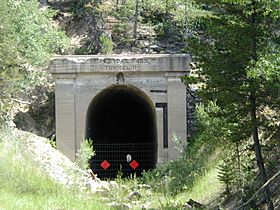Pipestone Pass (Montana) facts for kids
Quick facts for kids Pipestone Pass |
|
|---|---|

West portal of the Milwaukee Road's Pipestone Pass Tunnel.
|
|
| Elevation | 1,935 m (6,348 ft) |
| Traversed by | Montana State Route 2 and abandoned Milwaukee Road mainline (via Pipestone Tunnel). |
| Location | Silver Bow County, Montana, United States |
| Range | Rocky Mountains |
| Coordinates | 45°51.35′N 112°26.3′W / 45.85583°N 112.4383°W |
Pipestone Pass is a special place in the Rocky Mountains of Montana, United States. It's a mountain pass, which is like a lower area between mountains that makes it easier to travel through. This pass sits right on the Continental Divide, which is the line that separates rivers flowing to the Pacific Ocean from rivers flowing to the Atlantic Ocean.
You can find Pipestone Pass in Silver Bow County, Montana, about 10 miles south of Butte, Montana. It's located within the Beaverhead-Deerlodge National Forest. The pass is quite high up, reaching an elevation of about 6,453 feet (1,967 meters).
Trains and Tunnels at Pipestone Pass
For many years, Pipestone Pass was an important route for trains. A famous train company called the Chicago, Milwaukee, St. Paul and Pacific Railroad, often known as the Milwaukee Road, used this pass. They built a major train line here to connect cities like Chicago all the way to the Pacific Northwest.
This train line was part of a big project called the Pacific Extension, finished in 1909. To get through the mountains at Pipestone Pass, the railroad built a long tunnel. This tunnel, called the Pipestone Pass Tunnel, was about 2,290 feet long. It allowed trains to go under the pass at a lower elevation of 6,347 feet (1,935 meters).
In 1915, the train line became even more modern when it was electrified. This meant trains could run on electricity, which was a big step forward! The Milwaukee Road even ran a fancy passenger train called the Olympian (later the Olympian Hiawatha) through this tunnel. However, by 1980, the Milwaukee Road faced tough competition and financial problems. Because of this, they stopped using this important train line.
Roads Over the Pass
Pipestone Pass was also used by cars and trucks. An old highway called U.S. Route 10 crossed the Continental Divide here, starting in 1926. Unlike the trains, the road didn't use a tunnel to get over the pass.
Today, this road is known as Montana Highway 2. Locals sometimes call it "The Harding Way." This name was chosen to honor President Warren G. Harding. He visited Butte, Montana, and the road was named after him to celebrate his visit.

